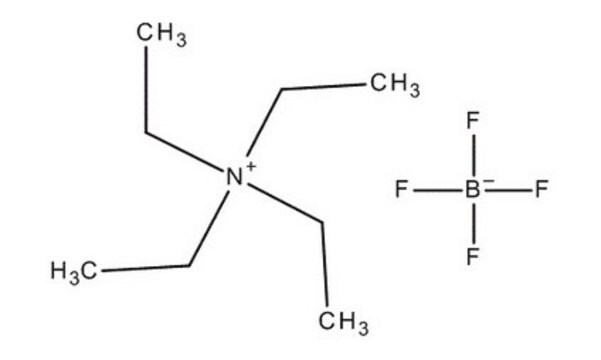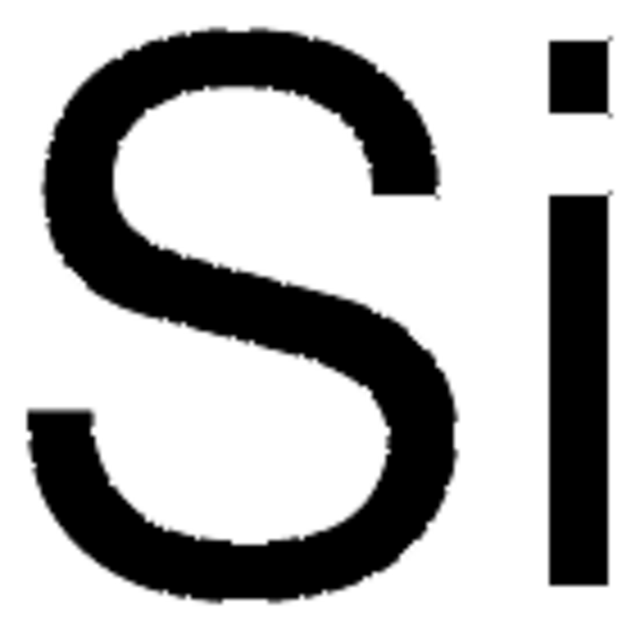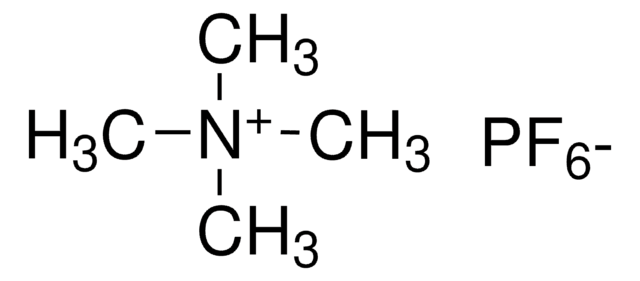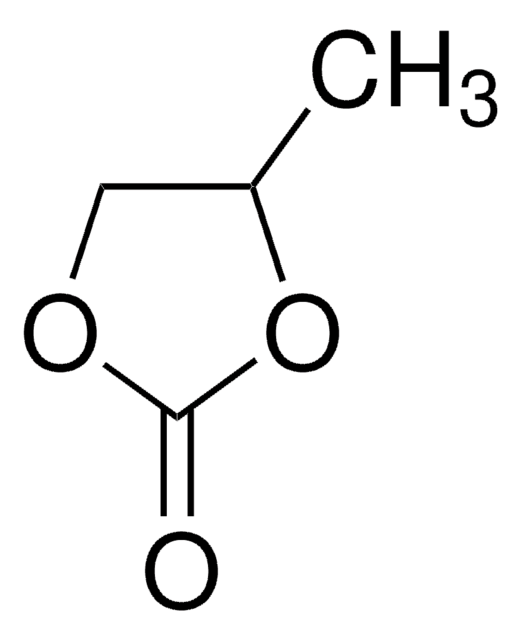86618
Tetraethylammonium tetrafluoroborate
for electrochemical analysis, ≥99.0%
About This Item
≥99.0%
Recommended Products
grade
for electrochemical analysis
Quality Level
Assay
≥99.0% (T)
≥99.0%
form
crystals
mp
≥300 °C (lit.)
solubility
acetonitrile: 0.1 g/mL, clear, colorless
SMILES string
F[B-](F)(F)F.CC[N+](CC)(CC)CC
InChI
1S/C8H20N.BF4/c1-5-9(6-2,7-3)8-4;2-1(3,4)5/h5-8H2,1-4H3;/q+1;-1
InChI key
XJRAKUDXACGCHA-UHFFFAOYSA-N
Looking for similar products? Visit Product Comparison Guide
General description
Application
- High-rate electrochemical capacitors based on ordered mesoporous silicon carbide-derived carbon: This study discusses the use of Tetraethylammonium tetrafluoroborate in enhancing the performance of high-rate electrochemical capacitors, focusing on ordered mesoporous silicon carbide-derived carbon structures (Korenblit et al., 2010).
- Exactly matched pore size for the intercalation of electrolyte ions determined using the tunable swelling of graphite oxide in supercapacitor electrodes: The application of Tetraethylammonium tetrafluoroborate in electrolyte solutions for supercapacitors, demonstrating how it facilitates the exact matching of pore sizes in graphite oxide electrodes for optimal ion intercalation (Sun et al., 2018).
- A universal model for nanoporous carbon supercapacitors applicable to diverse pore regimes, carbon materials, and electrolytes: Describes a modeling approach that incorporates the characteristics of Tetraethylammonium tetrafluoroborate in various carbon materials and electrolytes, enhancing the understanding and design of supercapacitors (Huang et al., 2008).
- Sub-micrometer Novolac-Derived Carbon Beads for High Performance Supercapacitors and Redox Electrolyte Energy Storage: Research on utilizing Tetraethylammonium tetrafluoroborate in novel sub-micrometer novolac-derived carbon beads, which significantly boost the efficiency and energy storage capacity of supercapacitors (Krüner et al., 2016).
- Biomass-based Hierarchical Porous Carbon for Supercapacitors: Effect of Aqueous and Organic Electrolytes on the Electrochemical Performance: Explores the efficacy of Tetraethylammonium tetrafluoroborate in enhancing the electrochemical performance of biomass-derived hierarchical porous carbons in various electrolyte environments (Chen et al., 2019).
Other Notes
Signal Word
Warning
Hazard Statements
Precautionary Statements
Hazard Classifications
Acute Tox. 4 Dermal - Acute Tox. 4 Inhalation - Acute Tox. 4 Oral - Eye Irrit. 2 - Skin Irrit. 2 - STOT SE 3
Target Organs
Respiratory system
Storage Class Code
11 - Combustible Solids
WGK
WGK 3
Flash Point(F)
Not applicable
Flash Point(C)
Not applicable
Personal Protective Equipment
Choose from one of the most recent versions:
Certificates of Analysis (COA)
Don't see the Right Version?
If you require a particular version, you can look up a specific certificate by the Lot or Batch number.
Already Own This Product?
Find documentation for the products that you have recently purchased in the Document Library.
Customers Also Viewed
Our team of scientists has experience in all areas of research including Life Science, Material Science, Chemical Synthesis, Chromatography, Analytical and many others.
Contact Technical Service











